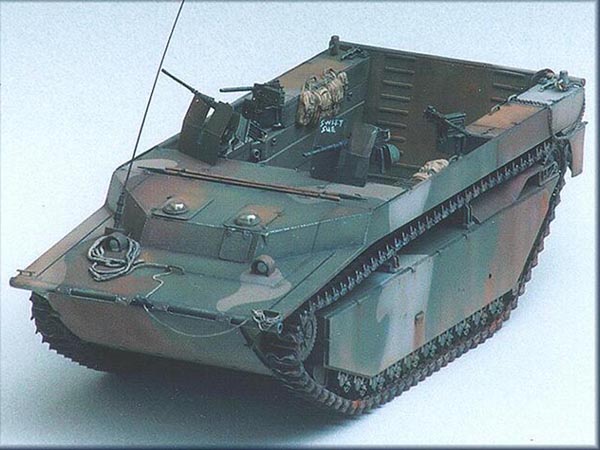LANDING VEHICLE
TRACK 4

By Moses
History
As H-hour drew near, Marines climb down rope nets slung over the sides
of their transports boarding box-like landing crafts bobbing with the waves.
Soon the overburdened amphibians will be taking its cargo of ammo, fuel
and seasick men into the unknown.
The imagery is cliché. But it is difficult to describe the Pacific
campaign of WW2 without conjuring a mental picture of the AMTRACS (Amphibious,
Track). It was these vehicles that made the Pacific island hopping campaign
attainable. The capture of those islands allowed American bombers and escorts
to operate from airfields within striking reach of Japan; ultimately leading
to Hiroshima and Nagasaki.
A common misconception was that the tracks were designed for operational
flexibility. While LVTs were utilized inland on certain occasions, such
as the Philippines, Okinawa, and Holland, it was never the designer’s true
intend. The tracks were adopted as means of enabling the craft to cross
very shallow waters where assault boats stand a good likelihood of becoming
stranded.
The Kit (Italeri 1:35)
The LVT-4 was one of the more successful designs in a long series of
AMTRACS. Entering service in early 1944, it saw service throughout the
Pacific, NW Europe and finally Southeast Asia during the immediate Post
War period. Until now this venerable machine was only available in 1:72
scale. Italeri’s decision to produce a 1:35 version was highly welcomed
and eagerly awaited by many.
Overall, the main components are clean and crisp requiring little clean
up. However, if the kit’s instructions were followed verbatim, one would
end up with a hybrid vehicle from the French Indochina conflict of the
1950s.
Conversion
Backdating this model to a more generalized WWII era troop/cargo transport
isn’t difficult. Best of all, all one need is a tube of putty, a few pieces
of scrap sheet styrene, a selection of sandpaper, and a shape knife. The
main steps were:
-
Removal of the molded-on cab hatches from the kit. The cab roof was puttied
and sanded flat.
-
New hatches were fashion from .01” plastic card and repositioned so they
sit parallel.
-
New driver’s periscope was “squash cast” from the kit’s original.
-
All vision ports and co-driver’s hull machine gun were omitted and filled
in.
-
A new driver’s forward cover was made using plastic card.
-
The headlights were shortened.
-
The front armour plate was chopped down so it longer wrap around the hull.
-
The kit’s water channels, while accurate in shape, were too thick. It was
easily remedied with sheet plastic using the kit parts as a template.
-
Plexiglas domes for the driver’s hatches were made using transparent heat
form sheet, which was drape cast onto a wooded dowel.
The list may appear long, but it is actually a lot of fun. It is
also an excellent introduction to conversions for those who desire to try
their hand at this particular aspect of model building.
Useful Reference
Books:
AMTRACS IN ACTION. Mesko, Jim, Squadron Signal Pub., 1993.
AMTRACS: US AMPHIBIOUS ASSAULT VEHICLES. Zaloga, Steve, Osprey, 1987.
Web:
UK Military
Modelling - Kit review.
Track-link.net
review - A very good review of the kit with additional information
on how to correct the model’s shortcomings.
UK Military
Modelling 2000 Home Page - Photos of a museum example.
Track-link.net
article on Squash Casting - A article explaining “Squash Casting.”

© ModelWarships.com

